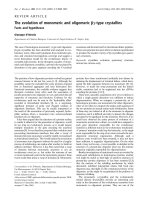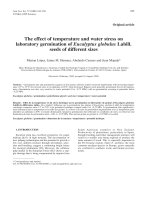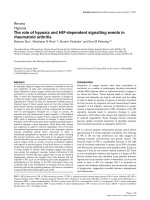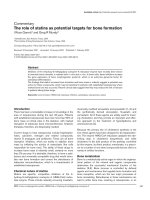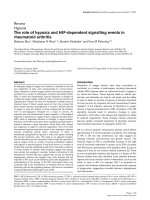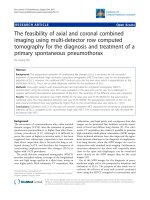Báo cáo y học: "The effect of provider- and workflow-focused strategies for guideline implementation on provider acceptance" pptx
Bạn đang xem bản rút gọn của tài liệu. Xem và tải ngay bản đầy đủ của tài liệu tại đây (663.75 KB, 10 trang )
BioMed Central
Open Access
Page 1 of 10
(page number not for citation purposes)
Implementation Science
Research article
The effect of provider- and workflow-focused strategies for
guideline implementation on provider acceptance
Mindy E Flanagan
1,2
, Rangaraj Ramanujam
3
and Bradley N Doebbeling*
1,2,4
Address:
1
VA Health Services Research & Development Center on Implementing Evidence-Based Practice, Roudebush VAMC, Indianapolis,
Indiana, USA,
2
IU Center for Health Services & Outcomes Research, Regenstrief Institute, Inc., Indiana University, Indianapolis, Indiana, USA,
3
Owen Graduate School of Management, Vanderbilt University Nashville, Tennessee, USA and
4
Division of General Medicine & Geriatrics,
Department of Medicine, Indiana University School of Medicine, Indianapolis, Indiana, USA
Email: Mindy E Flanagan - ; Rangaraj Ramanujam - ;
Bradley N Doebbeling* -
* Corresponding author
Abstract
Background: The effective implementation of clinical practice guidelines (CPGs) depends critically
on the extent to which the strategies that are deployed for implementing the guidelines promote
provider acceptance of CPGs. Such implementation strategies can be classified into two types
based on whether they primarily target providers (e.g., academic detailing, grand rounds
presentations) or the work context (e.g., computer reminders, modifications to forms). This study
investigated the independent and joint effects of these two types of implementation strategies on
provider acceptance of CPGs.
Methods: Surveys were mailed to a national sample of providers (primary care physicians,
physician assistants, nurses, and nurse practitioners) and quality managers selected from Veterans
Affairs Medical Centers (VAMCs). A total of 2,438 providers and 242 quality managers from 123
VAMCs participated. Survey items measured implementation strategies and provider acceptance
(e.g., guideline-related knowledge, attitudes, and adherence) for three sets of CPGs chronic
obstructive pulmonary disease, chronic heart failure, and major depressive disorder. The
relationships between implementation strategy types and provider acceptance were tested using
multi-level analytic models.
Results: For all three CPGs, provider acceptance increased with the number of implementation
strategies of either type. Moreover, the number of workflow-focused strategies compensated
(contributing more strongly to provider acceptance) when few provider-focused strategies were
used.
Conclusion: Provider acceptance of CPGs depends on the type of implementation strategies used.
Implementation effectiveness can be improved by using both workflow-focused as well as provider-
focused strategies.
Published: 29 October 2009
Implementation Science 2009, 4:71 doi:10.1186/1748-5908-4-71
Received: 7 March 2008
Accepted: 29 October 2009
This article is available from: />© 2009 Flanagan et al; licensee BioMed Central Ltd.
This is an Open Access article distributed under the terms of the Creative Commons Attribution License ( />),
which permits unrestricted use, distribution, and reproduction in any medium, provided the original work is properly cited.
Implementation Science 2009, 4:71 />Page 2 of 10
(page number not for citation purposes)
Background
Improving the quality of patient care requires the effective
implementation of clinical practice guidelines (CPGs)
that promote interventions of proven benefit and discour-
age ineffective interventions [1]. However, despite the
growing availability of CPGs for a wide range of clinical
conditions, the extent to which care providers adhere to
these guidelines varies widely. Concerns about the widen-
ing gap between the scientific knowledge incorporated in
CPGs and its utilization in practice have led to urgent calls
for more widespread and effective implementation [2,3].
Currently, there is a limited evidence base to determine
the most effective strategies for implementing CPGs [1].
The study reported here draws from a conceptual frame-
work on organizational change [4,5] and the emerging
work on implementation of CPGs [6-8] to investigate the
following questions: How does providers' acceptance of a
set of CPGs vary with the number of distinct strategies
used for implementing that set of CPGs? Specifically, how
does provider acceptance vary with the two commonly
used yet conceptually distinct types of implementation
strategies (i.e., provider-focused versus workflow-focused
implementation strategies)?
The effective implementation of CPGs results in changes
in the practices of care providers such that providers rou-
tinely follow the CPGs whenever appropriate. However,
the eventual practice change is preceded by a sequence of
cognitive-affective changes wherein providers become
aware of the guideline, agree with the guideline, decide to
adopt the practices, and adhere to the guideline as appro-
priate [9]. Therefore, rather than solely target the eventual
provider adherence, efforts to promote guideline-con-
cordant behaviors must also target other facets of provider
acceptance (i.e., guideline-related knowledge and atti-
tudes). It follows that an important task in implementa-
tion research is the identification and verification of
factors that influence provider acceptance of CPGs.
In general, adherence to guidelines is better when imple-
mentation strategies involve a widespread approach that
targets multilevel barriers (patient, provider, clinic, organ-
ization) to adherence [6]. By implementation strategies,
we refer to specific interventions (e.g., academic detailing,
grand rounds presentations) that are deployed to provide
the necessary information, knowledge, skills, incentives,
and the infrastructure for adherence. The potential impor-
tance of multi-faceted implementation strategies is well
recognized in implementation research [10-12]. However,
prior studies have focused mostly on the effects of multi-
faceted implementation strategies on adherence to guide-
lines but not provider acceptance. Yet, the organizational
change literature suggests that implementation efforts
provide early cues to people about the importance, useful-
ness, and ease of use of any proposed change [13]. In turn,
these cues shape employee acceptance and attitudes
toward change such as resistance or support and eventu-
ally to change-related behaviors. Applied to the imple-
mentation of CPGs, this suggests that different strategies
used in a multi-faceted approach to implementation strat-
egy might help shape provider acceptance of guidelines.
Specifically, provider acceptance might be more favorable
when more (and varied) rather than fewer implementa-
tion strategies are used.
However, studies that have investigated the effectiveness
of multi-faceted implementation approaches in promot-
ing adherence report mixed results. A recent review con-
cluded that there might not be a dose response effect
between the number of implementation strategies and
overall effectiveness [7]. That is, increasing the number of
implementation activities does not necessarily increase
adherence to guidelines. In contrast, others report that
multi-faceted approaches improve provider adherence
[14,15]. One possible explanation for mixed findings may
be that prior studies tended to treat all implementation
strategies alike. However, from an organizational change
perspective, implementation efforts typically target differ-
ent organizational components, such as work processes,
knowledge and skills of individuals, formal roles and
responsibilities, and organizational culture [4,12,16].
Whereas efforts to change culture may require long-term
change interventions, the other three components, which
essentially refer to work and providers in the context of
CPGs, can be changed through short-term interventions
[16].
Implementation strategies can be broadly classified as
being workflow-focused (e.g., clinical reminders provide
timely alerts about appropriate actions to change work
flow) or provider-focused (e.g., academic detailing, which
provides information about evidence-based practices to
the providers). Workflow-focused implementation strate-
gies involve changes in the task context relevant to a spe-
cific set of CPGs. They seek to minimize contextual
barriers to the adoption of CPGs and to put in place
changes that facilitate the routinized adoption of CPGs.
Examples of such strategies include changing the work
processes to incorporate the guidelines, introducing
reminder systems that provide timely alerts about CPGs,
redefining the roles and responsibilities for non-physician
staff in congruence with the requirements of the CPGs,
and revising forms/procedures [17,18]. By contrast, pro-
vider-focused implementation strategies involve commu-
nication with the providers about a specific set of CPGs.
They seek to minimize provider-level barriers to adher-
ence and to create provider-level facilitators to adherence.
Examples of such strategies include distributing informa-
tion about guidelines to promote awareness, organizing
Implementation Science 2009, 4:71 />Page 3 of 10
(page number not for citation purposes)
grand rounds to educate providers, conducting clinical
meetings to clarify the CPGs, and identifying champions
who can informally encourage providers to adopt CPGs.
In principle, the two types of strategies are complemen-
tary and the effective implementation of a CPG requires
both workflow-focused as well as provider-focused imple-
mentation strategies [16]. However, when multi-faceted
implementation strategies vary in their mix of these two
types of strategies, they may have different effects. In par-
ticular, given the same number of implementation strate-
gies, a more balanced mix (large number of workflow-
focused as well as provider-focused strategies) is more
likely to lead to acceptance because they provide informa-
tion about CPGs as well as facilitate adherence in the nor-
mal course of work.
The present study examined the implementation efforts
for three evidence-based CPGs in the Veterans Health
Administration (VHA) chosen for implementation as
national performance measures: chronic obstructive pul-
monary disease (COPD), chronic heart failure (CHF), and
major depressive disorder (MDD) [19-21]. See Table 1 for
details of these CPGs. These three guidelines were selected
because they represent key performance measures for the
VHA.
Methods
Sample
We sampled two populations for the present study: VHA
quality managers and VHA providers. The sampling frame
included 143 VAMCs with ambulatory care clinics. For the
quality manager survey, the sampling frame included 416
quality managers, primary care administrators, or other
personnel directly involved in CPG implementation in
their facility's primary care clinics. Regional level quality
managers were contacted to identify local quality manag-
ers and other primary care administrators involved in
guideline implementation at each facility in their region.
Local quality managers were then contacted to identify up
to two other personnel involved in guideline implemen-
tation in their primary care clinics. The goal was to have at
least one key informant from each facility who could
knowledgeably answer questions about CPG implemen-
tation at their facility. The sampling, survey procedure,
and instrument have been described in detail elsewhere
[18,22].
At each facility, we sought to identify at least eight physi-
cians, eight nurses, and four physician assistants (PA)
and/or nurse practitioners (NP), if available. The primary
goal of the parent project was to test organizational factors
predicting guideline compliance. Rather than using indi-
vidual provider data, these analyses were planned for
facility level comparisons using aggregated data. Thus, the
power calculations determined the number of responding
facilities, and not the number of providers sampled at
each facility. As a result, the number of providers sampled
from each facility was intended to be adequate for under-
standing the implementation context. Additionally, the
provider sample size per facility was based on pragmatic
and budget concerns. The randomly selected provider
sample included 4,621 providers. Providers who were
retired, deceased, not appropriate for participation (i.e.,
no longer providing primary care), or who had left the
VAMC were removed (n = 394) resulting in a final sample
of 4,227 providers, including 1,770 physicians, 1,643
nurses, and 814 PAs or NPs. PA and NP categories were
collapsed because some facilities employed either PAs or
NPs, but typically not both.
Surveys
Overview
Survey development was based on a literature review, our
existing instruments from prior studies of guideline
implementation in community facilities and VAMCs [23-
26], and findings from a multi-institutional focus group
study of barriers and facilitators to CPG implementation
[27]. The quality manager survey included items assessing
the following: perceptions of provider support, knowl-
edge, and adherence with CPGs; dissemination
approaches; information about guideline implementa-
tion task forces and committees; contextual factors associ-
ated with implementation; facility culture, cooperation,
and structure; and Veterans Integrated Service Network
(VISN) leadership involved in implementation. The qual-
ity manager instrument has been extensively used and val-
idated and is published [18,28,29].
Table 1: VHA clinical practice guidelines for COPD, CHF, and MDD.
Guideline Release date Content
Chronic obstructive pulmonary disease (COPD) April 2000 Recommendations for pharmacologic management, exacerbation, and patient
education
Chronic heart failure (CHF) February 2001 Recommendations for the pharmacologic management, physical examination,
diagnosis, and nonpharmacologic management
Major depressive disorder (MDD) May 2000 Recommendations for depression screening, assessment, and management
Implementation Science 2009, 4:71 />Page 4 of 10
(page number not for citation purposes)
The provider survey included items assessing the follow-
ing: provider knowledge of and agreement with CPGs;
provider support for CPGs; dissemination approaches;
provider patient care workload; facility culture, coopera-
tion, and structure; use of technology in implementation
and maintenance; performance feedback; and facility's
provision of information technology support. A demo-
graphic section was included in both surveys. The surveys
utilized a Likert-type response scale that ranged from one,
(not at all) to five (very great), wherever appropriate.
Implementation measures
CPG implementation was assessed separately for four
medical conditions: diabetes mellitus, COPD, CHF, and
MDD. Results for diabetes mellitus guideline implemen-
tation are not presented here because questions about
provider acceptance for this guideline were not included
in the survey.
The provider survey included questions about 14 distinct
implementation strategies with respect to each guideline:
academic detailing, clinical meetings, grand rounds, com-
plete guideline, brief summary, pocket card summary, sto-
ryboards, forms created or revised, responsibilities of non-
physicians changed, champion for the guideline, compu-
ter reminders, computer tools to document recom-
mended services, teleconferences, and personal digital
assistants. Using these responses, implementation strate-
gies were categorized as either provider-focused (e.g., clin-
ical meetings, copy of the complete guideline) or
workflow-focused (e.g., forms created, responsibilities of
non-physicians changed). See Table 2 for a list of pro-
vider-focused and workflow-focused implementation
strategies. A count variable was computed for number of
provider-focused implementation strategies (range zero
to ten) and for number of workflow-focused implementa-
tion strategies (range zero to four).
Similarly, the quality manager survey included a list of
possible implementation strategies used for each guide-
line. Because quality managers had access to information
about multiple implementation efforts, their reports were
used as a facility-level report of implementation activity.
With these data, a total count (versus two counts for the
two types of strategies) of implementation strategies was
created. We did not divide these reports to reflect the two
categories of strategies because we were not interested in
whether the facility report of these two implementation
strategies influenced provider acceptance. Rather, our pri-
mary question was whether providers' acceptance varied
with their awareness of the two types of strategies. There-
fore, the total count variable was used as a covariate in sta-
tistical models to account for the climate in which
implementation occurred. If more than one quality man-
ager survey was completed for a facility, then the average
number of implementation strategies was computed at
that facility (for each CPG).
Provider acceptance of COPD, CHF, and MDD guidelines
Six items assessed provider's acceptance of each of the
COPD, CHF, and MDD clinical guidelines. These items
included questions about knowledge, agreement, rele-
vance, and clarity of the COPD, CHF, and MDD guide-
lines. Also, two items asked whether the implementation
approach at their facility improved their knowledge and
delivery of best practices related to the guideline. The
response set for each item was a five-point Likert-type
scale that ranged from one (not at all) to five (very great).
The mean value of each provider's responses to these six
items with respect to each set of guidelines was used to
measure the provider's acceptance. A low score indicated
low acceptance and a high score indicated high accept-
ance.
Covariates
Covariates included provider gender (0 = male, 1 =
female), provider year of birth, tenure in provider's cur-
rent position (years), and general attitude toward CPGs.
In addition, because some of the providers did not
respond to all six items about provider acceptance, the
number of items that a provider responded to was
included as a covariate. We included a general attitude
measure toward CPGs so that we could account for gen-
eral dislike for CPGs and still test for differences among
Table 2: Operationalization of provider-focused and workflow-focused implementation strategies used in the study.
Provider-focused implementation strategies Workflow-focused implementation strategies
1. Academic detailing 1. Forms created or revised
2. Clinical meetings 2. Responsibilities of non-physicians changed
3. Grand rounds presentations 3. Computer reminders
4. Complete guideline distributed to providers 4. Computer tools to document recommended services
5. Brief summary distributed to providers
6. Pocket card summary distributed to providers
7. Storyboards
8. Champion for the guideline
9. Personal digital assistants given to providers
10. Teleconferences
Implementation Science 2009, 4:71 />Page 5 of 10
(page number not for citation purposes)
the three CPGs in provider acceptance. General attitude
toward CPGs was computed as the mean of seven items:
'In general, in your opinion, to what extent are the VA
clinical guidelines: 1) Likely to improve quality of care; 2)
Oversimplified or 'cookbook' medicine; 3) A challenge to
professional autonomy; 4) Good educational tools; 5)
Too complex to work with; 6) Not used routinely because
of workload;' and 7) 'In the past two years, when CPGs
were implemented in your facility, to what extent: Were
you hesitant to adopt guidelines?' (1 = not at all, 5 = very
great). Responses to items two, three, five, six, and seven
above were reverse scored so that a high score was indica-
tive of a favorable attitude toward CPGs.
Procedures
In 2001, the quality manager survey was administered
using a modified Dillman survey method. Initially, partic-
ipants received an introductory letter, information sum-
mary, survey, and letters of support. Non-respondents
received a reminder postcard one week later. Then, after
two weeks, non-respondents received the entire survey
packet again. Finally, follow-up phone calls were made to
those who had not returned surveys. A similar procedure
was followed in 2003 when the provider survey was
administered. The University of Iowa Institutional Review
Board and Iowa City VAMC research committees
approved all survey packet materials and procedures.
Statistical Analyses
First, descriptive statistics were generated for both the
quality manager and provider surveys using facility aver-
ages. Next, using a multilevel framework, we related pro-
viders' reports of the number of implementation strategies
within each class (provider- and workflow-focused) to
their acceptance of the guideline. Due to the nested nature
of these data (i.e., providers were nested within facilities),
using multilevel models (MLM; also known as hierarchi-
cal linear modeling) is appropriate [30]. In this situation,
providers sampled from one facility will be more similar
to one another than to providers from another facility.
This similarity may be due to working under the same set
of policies, with a specific patient population, or within
the same cultural context. Thus, the assumption of inde-
pendent observations is violated; and a typical linear
regression model would lead to spurious conclusions
[31].
MLMs are comprised of levels: level-one represents the
individual (provider), and level-two represents the group-
ing variable (facility). For provider i at facility j, the fol-
lowing equation predicting outcome y is appropriate: y
ij
=
α
j
+ β
j
x
ij
+ e
ij
. As shown, a provider's score on a certain out-
come is partially due to hospital differences. The intraclass
correlation (ICC) is one indicator of dependency among
observations (providers) from the same hospital. For the
present data, ICCs ranged from 0.03 to 0.07 indicating
that 3% to 7% of the total variance is due to facility mem-
bership. The use of MLM in this case would provide ben-
efits over using a fixed effects model.
In the present MLM analyses, provider-level predictors
included count of provider-focused and workflow-
focused implementation strategies, general attitudes
toward all CPGs, provider gender, provider year of birth,
provider tenure at the facility (in years), and number of
items for the outcome variable that contained responses.
The facility-level predictor included in the model was the
average number of implementation strategies used for
each guideline, as reported by quality managers at that
facility. Additionally, the three hypothesized two-way
interaction terms were included in the model. The out-
come variable was provider acceptance of three CPGs.
Separate models were tested for COPD, CHF, and MDD
guidelines. All analyses were conducted using SAS, version
9.1 (Cary, NC).
Results
Surveys were returned by 129 of the 143 VAMCs, repre-
senting a 90% response rate at the facility level. A total of
242 quality managers (58% response rate) and 2,438 pro-
viders (58% response rate) completed surveys. A single
quality manager survey was returned from 42 facilities.
However, follow-up indicated that most represented a sin-
gle institutional response, reached by consensus among
those surveyed. When multiple quality manager surveys
from a facility were returned, the total number of imple-
mentation strategies reported was averaged to create a
facility-level response. Using a general linear model for
each condition, we tested the effect of the number of
returned quality manager surveys (one, two, or three) on
the total number of implementation strategies for that
facility. No significant differences were detected.
Table 3 presents descriptive statistics for the participating
VAMCs. The 129 facilities used in these analyses were
widely distributed across the U.S. Notably, nearly half
(45%) of the facilities were members of the Council of
Teaching Hospitals. The mean size (number of beds) was
313; and, 16% of hospitals were located in rural areas. The
mean age of providers surveyed was 50 years. The sample
was more than half female (62%) and had an average
employment tenure at the facility of about 11 years. Of
those participating, 38% were physicians, 38% were regis-
tered nurses, and 13% were advanced registered nurse
practitioners. Internal medicine was the most frequently
reported clinical specialty (35%).
As shown in Table 4, the two most used provider-focused
implementation strategies were distributing the complete
guideline and providing a brief summary of the CPG. This
finding is consistent for COPD, CHF, and MDD. For
workflow-focused strategies, creating computer reminders
Implementation Science 2009, 4:71 />Page 6 of 10
(page number not for citation purposes)
and using computer tools to document recommended
services were the two most common strategies. Again, this
pattern is consistent for COPD, CHF, and MDD guideline
implementation.
Missing data
Due to concerns with missing data in the outcome varia-
bles potentially creating bias in our results, we compared
respondents and non-respondents. We identified a few
differences between these two groups. Non-respondents
were older, female, and had a longer tenure at the facility.
Additionally, non-respondents reported fewer implemen-
tation strategies (of both types). The covariates represent-
ing these differences are included in all models. Hence,
the results from the multilevel models are considered
valid.
Table 3: Descriptive characteristics of the participating Veterans Affairs Medical Centers (n = 129) and providers (n = 2,438).
Variable Percent or Mean (std dev)
Facility Characteristics
Member of teaching council 45%
Total facility beds 313 (272)
Located in metropolitan area 84%
Provider Characteristics
Age in years 50 (8.7)
Gender (% female) 62%
Duration employment at the facility 11 (8.4)
Professional Training
Physician 38%
Registered Nurse 38%
Physician Assistant 7%
Advanced Registered Nurse Practitioner 13%
Licensed Practical Nurse 0%
Other 6%
Specialty
Internal Medicine, General 35%
Internal Medicine, Specialty 17%
Family Medicine 9%
Geriatrics 7%
Other 35%
None 4%
Table 4: Percentage of providers (n = 2,438) reporting the use of 14 strategies for COPD, CHF, and MDD clinical guideline
implementation.
Implementation Strategies COPD
(%)
CHF
(%)
MDD
(%)
Provider-focused
Academic detailing 4.5 5.1 3.2
Clinical meetings 18.5 20.3 14.2
Grand rounds 12.3 13.9 8.9
Complete guideline 31.6 32.4 23.8
Brief summary 30.8 33.2 21.4
Pocket card 19.2 19.0 12.4
Storyboards 5.4 5.4 3.5
Champion for the guideline 17.0 18.5 12.4
Teleconferences 11.3 11.5 11.3
Personal digital assistants 1.2 1.4 1.1
Workflow-focused
Forms created 11.0 11.4 10.0
Responsibilities of non-physicians changed 14.2 12.5 15.2
Computer reminders 26.9 25.0 26.7
Computer tools to document recommended services 20.6 19.4 20.0
Note: COPD = Chronic Obstructive Pulmonary Disease, CHF = Chronic Heart Failure, MDD = Major Depressive Disorder.
Implementation Science 2009, 4:71 />Page 7 of 10
(page number not for citation purposes)
Type of implementation strategy related to acceptance of
clinical guidelines
The type of implementation strategy (provider-focused
versus workflow-focused) was related to provider accept-
ance of the COPD, CHF, and MDD guidelines. Both pro-
vider- and workflow-focused strategies were positively
related to acceptance (Table 5). Additionally, the number
of provider-focused strategies interacted with the number
of workflow-focused strategies to predict acceptance.
This interaction took a consistent form across the three
sets of guidelines (Figure 1). To plot the interactions, 'low'
and 'high' workflow-focused and provider-focused was
defined based on 20% and 80% values, respectively, of
the corresponding frequency distribution. These interac-
tions suggested that multi-faceted implementations,
which use both a high number of provider-focused and
workflow-focused strategies, were positively related to
acceptance of the COPD, CHF, and MDD guidelines.
Additionally, these interactions suggested that even when
relatively few provider-focused strategies were used, when
paired with a high number of workflow-focused strate-
gies, provider acceptance was similar to when a high
number of provider-focused strategies was used.
To test whether the interaction terms improved each
model, we compared the main effects only model to the
full model (main effects and the three interaction terms).
To conduct this comparison, we calculated the difference
in -2 Log Likelihood values between the main effects only
model and the full model for each condition. In all cases,
the full model demonstrated a significant improvement.
Discussion
Our findings suggest that the composition of the imple-
mentation strategies is critical for understanding provider
acceptance of CPGs. Specifically, a higher number of pro-
vider-focused strategies was associated with acceptance of
CPGs; providers from facilities endorsing a larger number
of provider-focused strategies reported more acceptance
of the guidelines. Significantly, this relationship was
stronger in facilities that endorsed fewer workflow-
focused strategies. In other words, provider-focused strat-
egies may more strongly influence provider acceptance
when such strategies are accompanied by fewer workflow-
focused strategies. Overall, provider acceptance of CPGs
for COPD, CHF, and MDD guidelines was lowest when
neither type of strategy was used and highest when both
strategies were used. Therefore, provider acceptance of
CPGs was best predicted by provider-focused and work-
flow-focused implementation strategies when they were
considered jointly.
Taken together, these findings offer one possible explana-
tion for the inconsistent findings about the effectiveness
of multi-faceted implementation strategies [7,14,15]. Pre-
vious studies, which provide mixed findings for the bene-
fits of a higher number of implementation strategies,
tended to treat all implementation strategies alike. How-
ever, as the current study indicates, the effects of the
number of strategies may depend on the composition of
strategies. For instance, the same number of provider-
focused strategies may have different effects on provider
acceptance, and, hence, on implementation depending
on whether the facility additionally uses more or fewer
Table 5: Parameter estimates from multi-level models predicting provider acceptance of COPD, CHF, and MDD guidelines.
Predictor COPD CHF MDD
Intercept 2.80*** 2.86*** 2.33***
Gender (0 = male, 1 = female) 0.02 -0.04 -0.01
Year of birth
Tenure (yrs)
-0.00
-0.01**
0.00
-0.00
0.00
0.00
General attitude toward CPGs 0.27*** 0.27*** 0.17***
Number of non-missing items included in outcome variable 0.32*** 0.35*** 0.26***
Number of facility-level implementation strategies 0.01 -0.00 -0.00
Number of provider-focused implementation strategies 0.15*** 0.15*** 0.19***
Number of workflow-focused implementation strategies 0.08*** 0.09*** 0.18***
Number of facility-level implementation strategies X provider-focused 0.00 0.00 0.00
Number of facility-level implementation strategies X workflow-focused 0.00 0.00 -0.01
Provider focused strategies X workflow focused strategies -0.02*** -0.03*** -0.04***
Note: COPD = Chronic Obstructive Pulmonary Disease, CHF = Chronic Heart Failure, MDD = Major Depressive Disorder. * p < 0.05, ** p <
0.01, *** p
< 0.001
Implementation Science 2009, 4:71 />Page 8 of 10
(page number not for citation purposes)
(top panel) Provider-focused strategies X Workflow-focus strategies interaction for COPD guideline; (middle panel) Provider-focused strategies X Workflow-focus strategies interaction for CHF guideline; (bottom panel) Provider-focused strategies X Workflow-focus strategies interaction for MDD guidelineFigure 1
(top panel) Provider-focused strategies X Workflow-focus strategies interaction for COPD guideline; (middle
panel) Provider-focused strategies X Workflow-focus strategies interaction for CHF guideline; (bottom panel)
Provider-focused strategies X Workflow-focus strategies interaction for MDD guideline.
Implementation Science 2009, 4:71 />Page 9 of 10
(page number not for citation purposes)
workflow-focused strategies. In particular, if a facility
already endorses a high number of workflow-focused
strategies, the marginal benefits of a further increase in the
number of provider-focused strategies may be limited.
Therefore, future studies of multi-faceted implementation
strategies should take into account differences across these
strategies.
The findings from the study have important implications
for efforts to implement CPGs. First, they suggest that, in
general, using more distinct implementation strategies
will help improve provider acceptance of guidelines. Sec-
ond, they also highlight the important question facing
implementation efforts how best to use the available
resources to elicit provider commitment to CPGs. This
goal, in turn, requires selection of strategies that are
directed at the providers as well as the workflow processes
in which the CPGs must be embedded. Although our find-
ings may be seen as implying that a large number of pro-
vider-focused strategies may be sufficient for improving
acceptance, we would caution against such an interpreta-
tion. A mix of implementation strategies may be not only
more efficient in using the available resources to improve
acceptance but also more effective in promoting sustained
adoption, which is the eventual goal of implementation
efforts.
This study has several important strengths that should be
emphasized. First, these data represent a large national
sample of VAMCs and their efforts to implement CPGs
across several chronic medical conditions. We considered
a broad spectrum of organizational and provider-focused
implementation strategies, based on the literature. Addi-
tionally, the multilevel aspect of this study adds strength
to the design and interpretation. We obtained and com-
pared data from multiple sources (i.e., quality managers
and providers), allowing us to consider simultaneous
effects on provider acceptance of CPGs. Specifically, we
were able to consider the implementation climate along
with providers' view of implementation efforts as they
influence a providers' acceptance of CPGs. With multiple
data sources, our interpretations apply to more than one
stakeholder group.
Some limitations of the current study design must be
noted. Although we obtained a broad assessment of
implementation efforts at the time of the survey, these
data were cross-sectional. Hence, it does not permit us to
draw causal inferences. While this study establishes asso-
ciations between implementation efforts and provider
acceptance, a longitudinal design will be needed to verify
the relationship between provider acceptance and the
implementation efforts used. Also, the current study
measured the user attitudes toward the guidelines but not
the extent to which the guidelines were being followed.
Further studies are needed to verify the link between pro-
vider acceptance and adherence to the specific process
measures from the guidelines considered in this study.
Further research is also needed to determine which types
of implementation strategies have the greatest sustained
effect. Finally, the generalizability of the findings from
this study to the target population may be limited due to
the observed differences between respondents and non-
respondents.
Our findings point to several other future research ques-
tions. What are the different classes of implementation
strategies, in addition to the ones considered here, that
might be relevant to understanding provider acceptance
and guideline adherence? The current study considered
some specific examples of provider-focused and work-
flow-focused strategies. What are some other specific strat-
egies that fall under these categories? What are the social
and cognitive processes that may help explain how the
increased number of strategies and the joint reliance on
different classes of implementation strategies lead to more
provider acceptance of and adherence with guidelines?
Conclusion
In conclusion, a multi-faceted implementation approach
leads to provider acceptance of clinical guidelines. Imple-
mentation may be most effective in achieving provider
buy-in when it relies on a mix of workflow-focused as well
as provider-focused strategies.
Competing interests
The authors declare that they have no competing interests.
Authors' contributions
MEF was primarily responsible for research questions (for
this manuscript), data analysis, and interpretation. RR
contributed to the interpretation, drafting, and revision of
the manuscript. BND was primarily responsible for study
design, survey materials, obtaining funding support, data
collection, and contributed to the interpretation, drafting
and revision of the manuscript.
Acknowledgements
This study was funded through the Department of Veterans Affairs, the
Veterans Health Administration, Health Services Research and Develop-
ment Service, Investigator Initiated Research Grants, #CPI99-126 and CPI
-01-141. MEF was a VA postdoctoral fellow in medical informatics. This
research was partially supported by VA HSRD Center grant #HFP 04-148.
We appreciate the contributions of the multiple investigators in our study
group at Iowa City (Thomas Vaughn, Marcia Ward, Robert Woolson, Steve
Flach, Toni Tripp-Reimer, Bernard Sorofman, Jane DeWitt) and Indianapo-
lis (Anne Chou, Jason Sutherland) who contributed to the design and con-
duct of the study. We also greatly appreciate the time and effort of
providers and managers who participated in the study. The views expressed
in this article are those of the authors and do not necessarily represent the
views of the Department of Veterans Affairs.
Publish with BioMed Central and every
scientist can read your work free of charge
"BioMed Central will be the most significant development for
disseminating the results of biomedical research in our lifetime."
Sir Paul Nurse, Cancer Research UK
Your research papers will be:
available free of charge to the entire biomedical community
peer reviewed and published immediately upon acceptance
cited in PubMed and archived on PubMed Central
yours — you keep the copyright
Submit your manuscript here:
/>BioMedcentral
Implementation Science 2009, 4:71 />Page 10 of 10
(page number not for citation purposes)
References
1. Grimshaw JM, Thomas RE, MacLennan G, Fraser C, Ramsay CR, Vale
L, Whitty P, Eccles MP, Matowe L, Shirran L, Wensing M, Dijkstra R,
Donaldson C: Effectiveness and efficiency of guideline dissem-
ination and implementation strategies. Health Technol Assess
2004, 8:6.
2. McGlynn EA, Asch SM, Adams J, Keesey J, Hicks A, DeCristofaro A,
Kerr EA: The quality of health care delivered to adults in the
United States. N Engl J Med 2003, 348:2635-2645.
3. Doebbeling BN, Vaughn TE, Woolson RF, Peloso PM, Ward MM,
Letuchy E, BootsMiller BJ, Tripp-Reimer T, Branch LG: Benchmark-
ing Veterans Affairs Medical Centers in the delivery of pre-
ventive health services: comparison of methods. Med Care
2002, 40:540-554.
4. Greenhalgh T, Robert G, Macfarlane F, Bate P, Kyriakidou O: Diffu-
sion of innovations in service organizations: systematic
review and recommendations. The Milbank Quarterly 2004,
82:581-629.
5. Tushman ML, Anderson P, (Eds): Managing Strategic Innovation and
Change: A Collection of Readings New York: Oxford University Press;
2004.
6. Grol R, Grimshaw J: From best evidence to best practice: effec-
tive implementation of change in patients' care. Lancet 2003,
362:1225-1230.
7. Grimshaw J, Eccles M, Thomas R, MacLennan G, Ramsay C, Fraser C,
Vale L: Toward evidence-based quality improvement: evi-
dence (and its limitations) of the effectiveness of guideline
dissemination and implementation strategies 1966-1998. J
Gen Intern Med 2006, 21(Suppl 2):S14-S20.
8. Rubenstein LV, Pugh J: Strategies for promoting organizational
and practice change by advancing implementation research.
J Gen Intern Med 2006, 21(Suppl 2):S58-S64.
9. Pathman D, Konrad T, Freed G, Freeman VA, Koch GG: The
Awareness-to-Adherence Model of the steps to clinical
guideline compliance: The case of pediatric vaccine recom-
mendations. Med Care 1996, 34:873-889.
10. Wensing M, Wollersheim H, Grol R: Organizational interven-
tions to implement improvements in patient care: A struc-
tured review of reviews. Implementation Science 2006, 1:2.
11. Davis DA, Taylor-Vaisey A: Translating guidelines into practice:
a systematic review of theoretic concepts, practical experi-
ence and research evidence in the adoption of clinical prac-
tice guidelines. Can Med Assoc J 1997, 157:408-416.
12. Feifer C, Ornstein SM, Jenkins RG, Wessell A, Corley ST, Nemeth LS,
Roylance L, Nietert PJ, Liszka H: The logic behind a multimethod
intervention to improve adherence to clinical practice guide-
lines in a nationwide network of primary care practices. Eval
Health Prof 2006, 29:65-88.
13. Klein KJ, Sorra JS: The challenge of innovation implementation.
Academy of Management Review 1996, 21:1055-1080.
14. Wensing M, Weijden T van der, Grol R: Implementing guidelines
and innovations in general practice: which interventions are
effective? Br J Gen Pract 1998, 48:991-997.
15. Chaillet N, Dubé E, Dugas M, Audibert F, Tourigny C, Fraser WD,
Dumont A: Evidence-based strategies for implementing
guidelines in obstetrics: a systematic review. Obstetrics & Gyne-
cology 2006, 108:1234-1245.
16. Nadler DA, Tushman ML: Organizational frame bending: prin-
ciples for managing reorientation. Academy of Management Exec-
utive 1989, 3:194-204.
17. Cabana M, Rushton J, Rush A: Applying a new framework to an
old problem. Gen Hosp Psychiatry 2002, 24:35-42.
18. Ward MM, Yankey JW, Vaughn TE, BootsMiller BJ, Flach SD, Welke
KF, Pendergast JF, Perlin J, Doebbeling BN: Physician process and
patient outcome measures for diabetes care: relationships
to organizational characteristics. Med Care 2004, 42:840-850.
19. VA/DoD Clinical Practice Guideline Working Group, Veterans
Health Administration, Department of Veterans Affairs and Health
Affairs, Department of Defense, Office of Quality and Performance
publication 10Q-CPGs/COPD-00: Management of Chronic Obstructive
Pulmonary Disease. Washington, DC 1999.
20. Pharmacy Benefits Management Strategic Healthcare Group and the
Medical Advisory Panel, Veterans Health Administration, Department
of Veterans Affairs; PRM-SHG Publication No. 00-0015: The Pharma-
cologic Management of Chronic Heart Failure. Washington, DC 2001.
21. VA/DoD Evidence Based Clinical Practice Guideline Working Group,
Veterans Health Administration, Department of Veterans Affairs, and
Health Affairs, Department of Defense; Office of Quality and Per-
formance publication 10Q-CPGs/MDD-00: Management of Major
Depressive Disorder in Adults in the Primary Care Setting. Washington, DC
2000.
22. Bootsmiller BJ, Yankey JW, Flach SD, Ward MM, Vaughn TE, Welke
KF, Doebbeling BN: Classifying the effectiveness of Veterans
Affairs guideline implementation approaches. Am J Med Qual
2004, 19:248-254.
23. Beekmann SE, Vaughn TE, McCoy KD, Ferguson KJ, Torner JC,
Woolson RF, Doebbeling BN: Hospital bloodborne pathogens
programs: program characteristics and blood and body fluid
exposure rates. Infect Control Hosp Epidemiol 2001, 22:73-82.
24. Doebbeling BN, Vaughn TE, McCoy KD, Beekmann SE, Woolson RF,
Ferguson KJ, Torner JC: Percutaneous injury, blood exposure,
and adherence to standard precautions: are hospital-based
health care providers still at risk? Clin Infect Dis 2003,
37:1006-1013.
25. McCoy KD, Beekmann SE, Ferguson KJ, Vaughn TE, Torner JC,
Woolson RF, Doebbeling BN: Monitoring adherence to Stand-
ard Precautions. Am J Infect Control 2001, 29:24-31.
26. Vaughn TE, McCoy KD, BootsMiller BJ, Woolson RF, Sorofman BA,
Tripp-Reimer T, Perlin J, Doebbeling BN: Organizational predic-
tors of adherence to ambulatory care screening guidelines.
Med Care 2002, 40:1172-1185.
27. Lyons SS, Tripp-Reimer T, Sorofman BA, DeWitt JE, BootsMiller BJ,
Vaughn TE, Doebbeling BN: Information technology for clinical
guideline implementation: perceptions of multidisciplinary
stakeholders. J Am Med Inform Assoc 2005, 12:64-71.
28. Doebbeling BN, Chou AF, Tierney WM: Priorities and strategies
for implementation of an integrated informatics and com-
munications technology system for evidence-based prac-
tices. J Gen Intern Med 2006, 21(Suppl 2):S98-S105.
29. Subramanian U, McCoy KD, Sutherland JM, Welke KF, Vaughn TE,
Doebbeling BN: Provider process measures for chronic heart
failure care: relationship to organizational characteristics.
Med Care 2007, 45:28-45.
30. Snijders T, Bosker R: Multilevel analysis: an introduction to basic and
advanced multilevel modeling Thousand Oaks, CA: Sage; 1999.
31. Greenfield S, Kaplan SH, Kahn R, Ninomiya J, Griffith JL: Profiling
care provided by different groups of physicians: Effects of
patient case-mix (bias) and physician-level clustering on
quality assessment results.
Ann Intern Med 2002, 136:111-121.


